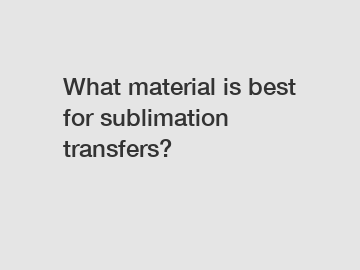What material is best for sublimation transfers?
When it comes to sublimation transfers, choosing the right material is crucial for achieving vibrant, long-lasting results. Sublimation transfers involve printing a design onto a special sublimation paper or film, which is then transferred onto a substrate using heat and pressure. The material used for the transfer can greatly impact the final outcome, including the color payoff, durability, and overall quality of the finished product. In this article, we will discuss the best materials for sublimation transfers and what to consider when choosing the right one for your project.
## Sublimation Paper.
Sublimation paper is a common choice for sublimation transfers due to its ability to hold and transfer ink effectively. This paper is specially coated to absorb the sublimation ink and release it when heat is applied. The key factors to consider when choosing sublimation paper include weight, coating, and size. Heavier weight papers are more durable and can withstand higher temperatures, while a high-quality coating will produce sharp and vibrant prints. Additionally, choosing the right size paper is important to ensure that your design fits correctly on the substrate.

## Sublimation Film.
Sublimation film is another popular option for sublimation transfers, particularly for more complex designs or specialty applications. This clear film is used to print a design, which is then transferred onto the substrate. Sublimation film is often preferred for items with curved or uneven surfaces, as it can conform to the shape of the object more easily than paper. When choosing sublimation film, make sure to select a high-quality product that will produce clear, sharp prints and adhere well to the substrate.
## Sublimation Blanks.
In addition to the transfer material itself, the substrate you choose can also impact the quality of the sublimation transfer. Sublimation blanks are specially treated items that are designed to work well with sublimation transfers, such as mugs, phone cases, apparel, and more. When selecting sublimation blanks, consider factors such as the material, coating, and color to ensure the best results. Materials like polyester, ceramic, and certain plastics are ideal for sublimation transfers, as they are able to absorb the ink and create vibrant, long-lasting designs.
## Other Considerations.
In addition to the specific material used for the sublimation transfer, there are a few other factors to consider to ensure the best results. These include:
- Heat press: Using a high-quality heat press with even temperature and pressure distribution is essential for achieving consistent and vibrant sublimation transfers.
- Ink quality: Using sublimation-specific ink that is compatible with your printer and transfer material is crucial for achieving the best results.
- Color management: Calibrating your printer and monitor, as well as using color profiles, can help ensure accurate color reproduction in your sublimation transfers.
In conclusion, choosing the right material for sublimation transfers is essential for achieving high-quality and long-lasting results. Whether you opt for sublimation paper, film, or blanks, selecting the best product for your specific project can make a significant difference in the outcome. By considering factors such as weight, coating, substrate material, and other considerations, you can create vibrant and professional-looking sublimation transfers for a wide range of applications.
For more information on sublimation transfers and materials, feel free to contact us.
For more information, please visit oem sublimation paper, jumbo roll sublimation paper factory, sublimation paper jumbo roll.
122
0
0


Comments
All Comments (0)